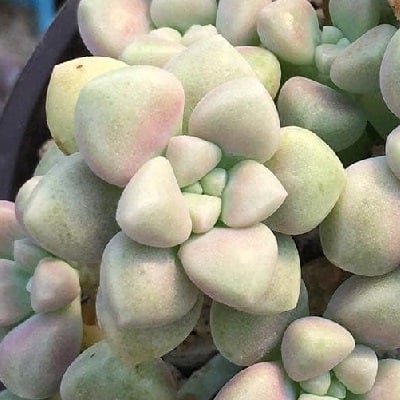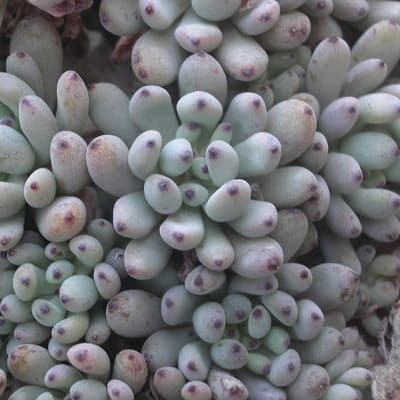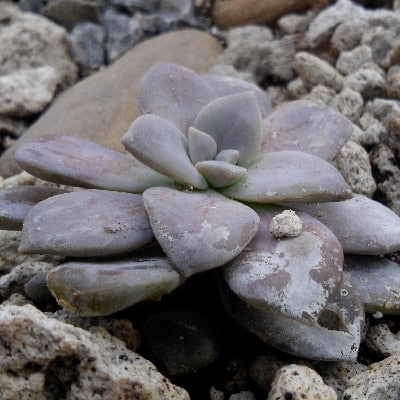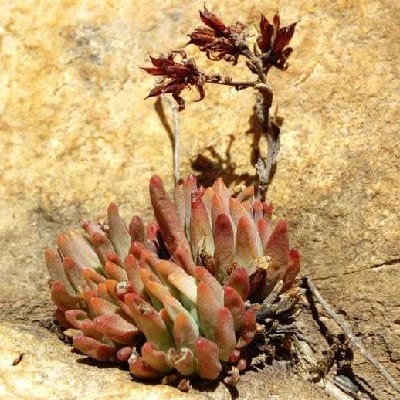20 Graptopetalum Succulents: Varieties, Care, and Propagation
Graptopetalum succulents are a type of plant that you might come across in Arizona and Mexico. They have a really cool shape that looks like a rosette, and they’re often known as ghost plants or leatherpetals. In this blog, we will explore the wide range of Graptopetalum types available. It’ll be super helpful for you if you want to easily recognize them. And if you’re interested in growing these plants at home, don’t worry! We’ve got a guide for taking care of them and even propagating them. So let’s dive in and learn all about these awesome Graptopetalum succulents!
Contents
- 1 Types of Graptopetalum Succulents
- 2 Graptopetalum Species and Varieties
- 2.1 Graptopetalum amethystinum
- 2.2 Graptopetalum bartramii
- 2.3 Graptopetalum bellum
- 2.4 Graptopetalum filiferum
- 2.5 Graptopetalum fruticosum
- 2.6 Graptopetalum macdougallii
- 2.7 Graptopetalum mendozae
- 2.8 Graptopetalum ‘Mirinae’
- 2.9 Graptopetalum pachyphyllum
- 2.10 Graptopetalum paraguayense
- 2.11 Graptopetalum pentandrum
- 2.12 Graptopetalum ‘Purple Haze’
- 2.13 Graptopetalum rosanevadoensis
- 2.14 Graptopetalum rusbyi
- 2.15 Graptopetalum saxifragoides
- 2.16 Graptopetalum sinaloensis
- 2.17 Graptopetalum ‘Victor Kane’
- 3 How to Care for Graptopetalum Succulents
- 4 How to Propagate Graptopetalum Succulents
- 5 FAQs
Types of Graptopetalum Succulents
Among the diverse Graptopetalum succulents, each with its own unique characteristics, you’ll find an array of stunning Graptopetalum varieties. Some Graptopetalum hybrids, resulting from careful breeding and cultivation, offer a blend of characteristics from various Graptopetalum species, resulting in captivating and distinct plants.




















Related Post:
1,000 Types of Succulents With Pictures
Graptopetalum Species and Varieties
Graptopetalum amethystinum

Graptopetalum amethystinum is a beautiful succulent that grows slowly and forms rosettes on long stems. The rosettes can reach a diameter of 6 inches and have rounded leaves that start off rose-colored, then turn grey with a powdery coating. The star-shaped flowers are whitish-yellow to pale yellow and have dark red crossbands.
Graptopetalum bartramii

Graptopetalum bartramii is a rare succulent species known as Bartram’s stonecrop or Patagonia Mountain leatherpetal. It’s found in Arizona and is being evaluated for listing as an endangered species. It has thick, pointed leaves that come in pale blues, greens, and purples. In autumn, it sends up stalks with seeds for propagation and prefers shaded areas near water sources.
Graptopetalum bellum

Graptopetalum bellum is a small succulent that forms rosettes of grey or bronze leaves. It grows up to 3 inches tall and spreads slowly through offsets. The rosettes can reach 4 inches in diameter. The triangular leaves are about 1.5 inches long, and the star-shaped flowers are deep pink to red and appear on branched inflorescences.
Graptopetalum filiferum

Graptopetalum filiferum is a unique succulent that grows in clumps and sprouts pups before forming a cluster. The rosettes are flat to the ground and can reach 4 inches in diameter, with 75 to 100 leaves. The fleshy leaves are spatulate to triangular and have a metallic green color with fine red tips. The white flowers are spotted with red.
Graptopetalum fruticosum

Graptopetalum fruticosum is an inconspicuous, shrub-like succulent found in coastal mountains in Mexico. It has attractive red-dotted flowers.
Graptopetalum macdougallii

Graptopetalum macdougallii is a succulent plant with rosettes arranged on stems. It may form clumps and has a shimmering blue-white color due to a protective waxy powder on the leaves. The flowers have five petals marked with dense red lines.
Graptopetalum mendozae

Graptopetalum mendozae is a small shrub-like succulent with erect or pendant stems. The rosettes have pale gray leaves that darken in the summer. It grows up to 6 inches tall, and the flowers are small, star-shaped, and white.
Graptopetalum ‘Mirinae’

Graptopetalum ‘Mirinae’ is a perennial succulent that forms rosettes. It looks similar to Graptopetalum mendozae but has different rosette shapes and flowers with tiny red dots. The rosettes are about an inch in diameter, and the flowers are small, with 3, 4, or 5 petals.
Graptopetalum pachyphyllum

Graptopetalum pachyphyllum is a low-growing succulent with sprawling stems and blue-green leaves tipped with red. The stems can reach 8 inches long, and the flowers are white-green with dark red bands.
Graptopetalum paraguayense

Graptopetalum paraguayense is a clump-forming succulent with thick, fleshy leaves that resemble those of the Echeveria plant. It’s also known as Mother-of-pearl-plant or Ghost plant because of its greyish-white, opalescent leaves. The stems can grow up to 12 inches long, and the rosettes reach 4 inches in diameter. In hot and dry conditions, the plant turns pinkish-yellow, while in partial shade and regular water, it becomes blue-gray. It produces star-shaped white-and-red flowers in spring.
Graptopetalum paraguayense subsp. bernalense

Graptopetalum paraguayense subsp. bernalense is a clumping species with relatively small rosettes of leaves that are not more than 1.6 inches long. The rosettes are about 4 to 8 inches high and 2-3 inches in diameter. The flowers are whitish and weakly spotted or plain.
Graptopetalum pentandrum

Graptopetalum pentandrum is a shrublet succulent that forms rosettes at the ends of woody stems. The rosettes are up to 3 inches in diameter, and the stems can grow up to 6 inches long. The bluish-green leaves may later turn yellowish-grey with a lavender hue, and the flowers have yellowish-white petals with red markings.
Graptopetalum pentandrum subsp. superbum

Graptopetalum pentandrum subsp. superbum forms rosettes at the end of thick stems. The rosettes are open, flat, and up to 5 inches in diameter. The leaves are pale gray-lavender to pink, and the inflorescences can reach up to 2 feet tall. The star-shaped flowers have greenish-yellow petals with red markings.
Graptopetalum ‘Purple Haze’

Graptopetalum ‘Purple Haze’ is a clump-forming succulent with sprawling stems and rosettes of plump leaves. The rosettes can grow up to 4 inches in diameter. The leaves are glaucous grey with raspberry blotches in winter. The flowers resemble Graptopetalum paraguayense but always have red flecks.
Graptopetalum rosanevadoensis

Graptopetalum rosanevadoensis closely resembles Graptopetalum superbum and Graptopetalum pentandrum. It has larger rosettes with more numerous leaves and different branching patterns.
Graptopetalum rusbyi

Graptopetalum rusbyi is a perennial succulent that forms stemless or short-stemmed rosettes. In spring, it develops flower spikes with pale flowers that have dark red and yellow dots towards the center of the petals. The flowers have a distinctive smell.
Graptopetalum saxifragoides

Graptopetalum saxifragoides is a mat-forming succulent with dense rosettes of pale green or reddish leaves. The rosettes can reach 1.5 inches in diameter, and the leaves are up to half of an inch long. The flowers are creamy-white to yellowish and patterned with brownish-violet.
Graptopetalum sinaloensis

Graptopetalum sinaloensis is a small succulent endemic to south-central Sinaloa, Mexico. It differs from other Graptopetalum species in the number of flower petals and the type of inflorescence. It prefers rocky areas near water sources.
Graptopetalum ‘Victor Kane’

Graptopetalum ‘Victor Kane’ is a compact succulent with rosettes of fleshy leaves that have a powdery coating and pastel coloration. The rosettes can reach 4 inches in diameter. The flowers are small, star-shaped, and white with red flecks. It’s often mistaken for Graptopetalum ‘Purple Haze’, but the leaves and the intensity of the red flecks distinguish the two hybrids.
How to Care for Graptopetalum Succulents
Taking care of Graptopetalum succulents is relatively easy once you understand their specific needs. Let’s dive into the essential care conditions for these plants:
Light
Graptopetalum plants thrive in bright sunlight, so it’s crucial to place them in a spot that receives several hours of direct sunlight each day. Whether you choose to keep them indoors or outdoors, find a sunny spot on a balcony or windowsill.
While Graptopetalum can tolerate some shade, a combination of sunlight and shade works best for optimal growth. Keep in mind that the amount of light they receive may influence their color variations.
These plants generally do well in hot climates, but they are also tolerant of colder temperatures to some extent. They typically grow in USDA zones 7b to 9a, or even more.
Watering
If you’re growing Graptopetalum outdoors, watering once a week should suffice. However, if you have them as indoor plants, they require less frequent watering due to the slightly lower temperatures indoors.
Allow the soil to dry out before watering again to prevent overwatering, which can lead to root rot and swelling inhibiting their growth. The watering frequency may also vary depending on the climate you live in. In humid climates, you can water less frequently, and during winter, you can reduce watering to once every two or three weeks.
Related Post:
How Often to Water Succulents
Soil
To ensure proper drainage, it’s important to use porous or well-draining soil for Graptopetalum succulents. You can either purchase a soil mix specifically for succulents or create your own by combining potting soil with perlite, sand, peat, and compost.
In humid regions with high rainfall, it’s beneficial to make the soil loose and coarse so that excess water can drain out. If planting these succulents, slightly raising the plant bed can also aid in drainage.
Related Post:
Best Soil for Succulents in Pots
Fertilizing
Graptopetalum succulents can thrive even without fertilizers. However, during the growing season, you can provide a small amount of diluted fertilizer to boost their growth. Be cautious not to apply too much fertilizer, as it can harm the plant. Alternatively, natural methods like compost can be sufficient in most cases if you prefer not to use fertilizer.
Related Post:
Best Fertilizer for Succulents
Pests and Diseases
Common pests and diseases that affect Graptopetalum succulents include mealybugs, which can infest various parts of the plant. Spot them early and eliminate them using pesticides or rubbing alcohol.
Additionally, avoid overwatering and overfertilizing, as these practices can lead to swelling and other issues.
How to Propagate Graptopetalum Succulents

You can propagate Graptopetalum succulents using seeds, leaves, or cuttings. Follow these steps for detailed propagation instructions:
- If using leaves or cuttings, ensure they are obtained from mature plants and keep some of the roots intact with the leaf clusters.
- Let the stem cuttings or leaf clusters dry and rest for a few days before planting. The cuttings may swell slightly during this time.
- Prepare a pot or container and fill it with the recommended soil mix.
- Plant the seeds, leaves, or cuttings into the soil.
- Lightly water the plant, being careful not to overwater. Initially, keeping the soil slightly moist should be sufficient.
- Within a couple of weeks, roots will develop from the leaves or cuttings and grow into small plants. Germination of seeds may take a bit longer.
- Continue with regular care for the propagated plants.
- Once the plant has grown sufficiently, transplant it carefully into a larger container.
FAQs
Is Graptopetalum cold hardy?
Graptopetalum succulents are relatively cold-hardy and can withstand frost to some extent. However, they have limits and may not survive extremely cold conditions. If you live in an area with very cold winters, it’s advisable to bring the plants indoors for protection. These plants can tolerate temperatures as low as 14°F.
How big do Graptopetalum grow?
Given enough space, Graptopetalum succulents can grow up to 12-20 inches in width. In terms of height, they can reach 6-12 inches tall. If you’re growing them in pots at home, their size will be constrained by the size of the pot.
